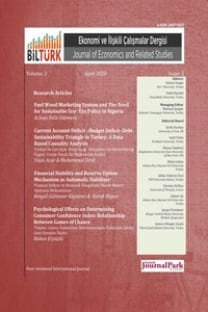Tourism and Economics of Transportation: A Macroeconomic Perspective
The paper examines the nexus between tourism and economics of transportation with a new asymmetric panel causality test, developed by Hatemi-J et al (2015) for BRIC-T countries during 1995 and 2017. After some preliminary (homogeneity, cross-section dependence, unit root tests) and co-integration test some selected variables such as real exchange rate, inflation rate and trade are added to the empirical model. The purpose here is to determine the contribution of macroeconomic indicators on tourism growth.The results show that there is a co-integration between number of tourist arrivals and tourism receipts as well as transportation costs. Also, negative cumulative tourism shock causes positive tourist arrivals shocks and positive cumulative tourism receipts shocks cause negative transportation costs. Hence, there is a causality between variables only in these conditions. Contribution of inflation rate and number of tourist arrivals have the biggest effect on tourism growth. We may say that from a macroeconomic perspective demand side is more dominant than supply side of tourism sector.
Anahtar Kelimeler:
Tourism growth, Transportation cost, causality, BRICT
Tourism and Economics of Transportation: A Macroeconomic Perspective
The paper examines the nexus between tourism and economics of transportation with a new asymmetric panel causality test, developed by Hatemi-J et al (2015) for BRIC-T countries during 1995 and 2017. After some preliminary (homogeneity, cross-section dependence, unit root tests) and co-integration test some selected variables such as real exchange rate, inflation rate and trade are added to the empirical model. The purpose here is to determine the contribution of macroeconomic indicators on tourism growth.The results show that there is a co-integration between number of tourist arrivals and tourism receipts as well as transportation costs. Also, negative cumulative tourism shock causes positive tourist arrivals shocks and positive cumulative tourism receipts shocks cause negative transportation costs. Hence, there is a causality between variables only in these conditions. Contribution of inflation rate and number of tourist arrivals have the biggest effect on tourism growth. We may say that from a macroeconomic perspective demand side is more dominant than supply side of tourism sector.
Keywords:
tourism growth, transportation cost, causality, BRICT,
___
- Bimonte, S., Ferrini, S. & Grilli, G. (2015). Transport infrastructures, environment impacts and tourists’ welfare: A choice experiment to elicit tourist preferences in Siena–Italy. Journal of Environmental Planning and Management, 0(0), 1-20.
- Breusch, T. S. & Pagan, A. R. (1980). The lagrange multiplier test and its application to model specifications in econometrics. Review of Economic Studies, 47, 239–253.
- Chan, F., Lim, C., & McAleer, M. (2005). Modelling multivariate international tourism demand and volatility. Tourism Management, 26(3), 459-471.
- Erkan, İ. & Erkan Şimşek, A. (2015). Tourism and air transportation in Turkey, International Journal of Business Tourism and Applied Sciences, 3(1): 34-40.
- Gunduz, L & Hatemi-J, A. (2005). Is the tourism-led growth hypothesis is valid for Turkey? Applied Economic Letters, 12(8): 499-504.
- Jeganathan, G. S & Srinivasulu, Y. (2017). Impact of tourism on macro-economic indicators: A comparison study of BRICS nations, IJARIIE, 3(4): 2395-4369.
- Hatemi-J, A. (2011). Asymmetric panel causality tests with an application to the impact of fiscal policy on economic performance in Scandinavia, Munich Personal RePEc Archive, https://mpra.ub.uni-muenchen.de/55527/1/MPRA_paper_55527.pdf , 20.11.2018.
- Hatemi-j, A., N. Ajmi, Ghassen, A. El Montanasser, R., Inglesi, Lots & Rangan Gupta (2015). Reserach output and economic growth in G7 countries: new evidence from asymmetric panel causality testing, Applied Economics, November, 1-8.
- Hatemi-J, A., Chang, T., Wen-Yi, C., Feng-Li, L. & Gupta, Rangan (2015). Asymmetric Granger causality between military expenditures and economic growth in top six defense suppliers, University of Pretoria, Department of Economics Working Paper Series, September.
- Hatemi-J, A. & El-Khatib, Y. (2016). An extension of the asymmetric causality tests for dealing with deterministic trend components, Applied Economics, 48(42), 4033-4041.
- Kizilkaya, O, Sofuoglu, E. & Karacor, Z. (2016). Türkiye’de turizm gelirleri ekonomik büyüme ilişkisi: ARDL sınır testi yaklaımı, Celal Bayar İİBF Dergisi, 23(1): 203-215.
- Kovacic, M. & Milosevic, T. (2016). Interdependence of transport and tourism, Pomorski Zbornik, 52, 99-111.
- Lumsdon, L. (2010). Transport and tourism: Cycle tourism – A model for sustainable development?, Journal of Sustainable Tourism, 1(5), 361-377.
- Martinez-Zarzosso, I. & Nowak-Lehman, F. D. (2007). Is distance a good proxy for transport costs: The cas of competing transport models, The Journal of International Trade Economic Development, 16(3), 411-434.
- Pesaran, M. H. (2004). General diagnostic tests for cross-section dependence in panels. IZA Discussion Paper, 1240, 1-39.
- Pesaran, H. M. (2006). Estimation and inference in large heterogeneous panels with a multifactor error structure. Econometrica, 74(4), 967-1012.
- Pesaran, H. M. (2007). A simple panel unit root test in the presence of cross section dependence. Journal of Applied Econometrics, 22(2), 265-312.
- Pesaran, H. M. & Yamagata, T. (2008). Testing slope homogeneity in large panels. Journal of Econometrics, 142: 50-93.
- Pesaran, H. M., Smith, V. L. & Yamagata, T. (2013). Panel unit root tests in the presence of multifactor error structure. Journal of Econometrics, 173, 94-115.
- Pop, L. (2014). The role of tourism in the economies of BRICS countries, Knowledge Horizons – Ecnomics, 6(2): 136-141.
- Proenca, S., & Soukiazis, E. (2008). Tourism as an economic growth factor: a case study for Southern European countries. Tourism Economics, 14(4), 791-806.
- Sorupia, E. (2005). Rethinking the role of Transportation in Tourism. Proceedings of the Eastern Asia Society for Transportation Studies, 5, 1767-1777.
- Westerlund, J. (2007). Testing for error correction in panel data. Oxford Bulletin of Economics and Statistics, 69(6), 709-748.
- Troung, N. V. & Shimizu, T. (2017). The effect of transportation on tourism promotion: Literature review on application of the Computable General Equilibrium (CGE) model. Transportation Research Procedia, 25, 3096-3115.
- Yayın Aralığı: Yılda 4 Sayı
- Başlangıç: 2019
- Yayıncı: Fatih DEYNELİ
Sayıdaki Diğer Makaleler
Tourism and Economics of Transportation: A Macroeconomic Perspective
Ebrima K. CEESAY, Momodou Mustapha FANNEH, Joseph Bm. TSENKWO
Economic Consequences of Syrian Refugees in Turkey
Microfinance and The Improvement of Social Welfare of Beneficiary Households: Evidence from Tunisia
